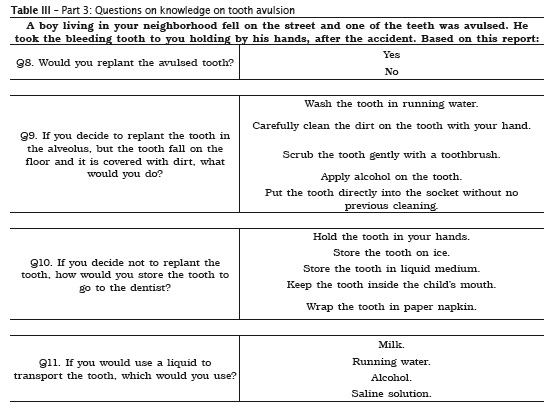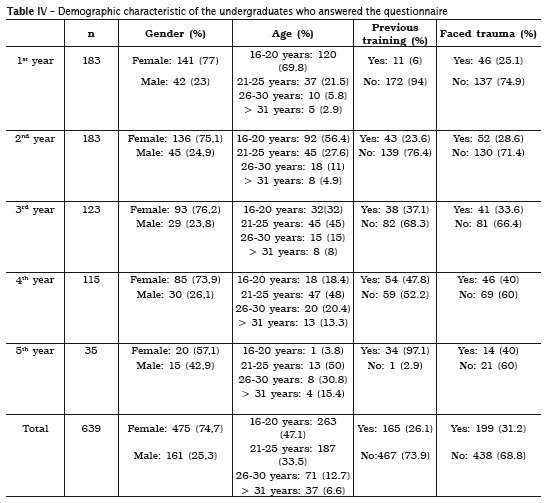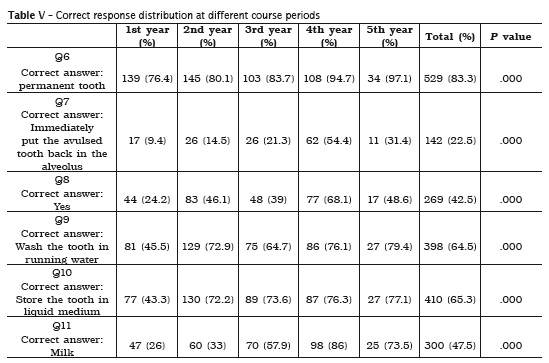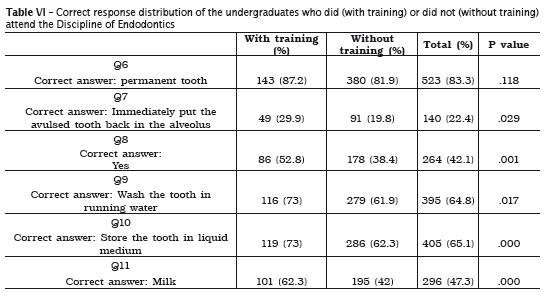Services on Demand
Article
Related links
Share
RSBO (Online)
On-line version ISSN 1984-5685
RSBO (Online) vol.13 n.4 Joinville Oct./Dec. 2016
ORIGINAL RESEARCH ARTICLE
Assessment of the Dentistry undergraduates' knowledge on tooth avulsion
Evandro ReynardI; Felipe Guilherme JanssonI; Kauhanna Vianna de OliveiraI; Bruno Marques da SilvaI; Luciana Stadler DemenechI; Denise Piotto LeonardiI; Flávia Sens Fagundes TomazinhoI
I Department of Dentistry, Positivo University– Curitiba – PR – Brazil
ABSTRACT
Introduction: Dental trauma affects mainly children, teenagers and young adults and the anterior teeth. In dental avulsion, the teeth are completely displaced out of the socket. This dentoalveolar lesion is that causing the most severe functional, esthetic, and psychologic damage to the patient. Objective: To evaluate the knowledge level of Dentistry undergraduates on tooth avulsion and verify whether the course period would be associated with the knowledge level. Material and methods: A questionnaire adapted from Fujita et al.. 5, was applied, consisting of three parts, Part 1: general demographic data; Part 2: questions about the experience in tooth trauma Part 3: knowledge about tooth avulsion. The questionnaire was applied to 706 Dentistry undergraduates from Positivo University (PR), in June, 2015. The chi-square test was used to identify differences in responses for different variables, with significance level of 5%. Results: Most of the students were at the age range from 16 to 20 years-old (47.1%), were female (74.7%), were not trained on first-aid care in cases of tooth trauma (73.9%), and never faced a case of tooth avulsion (68.8%). The course period was statistically and positively associated with the knowledge on dental avulsion. Conclusion: The evaluated Dentistry undergraduate students knew how to manage cases of tooth avulsion. Statistically significant differences occurred in relation to the course period and the knowledge on tooth avulsion.
Keywords: tooth avulsion; knowledge; education, dental; tooth injuries.
Introduction
Dental trauma affects mainly children, teenagers and young adults and the anterior teeth. In dental avulsion, the teeth are completely displaced out of the socket. 9 This dentoalveolar lesion is that causing the most severe functional, esthetic, and psychologic damage to the patient. 2
Tooth avulsion is a complex traumatic lesion, characterized by severe damages to the periodontal and pulp tissue. According to the literature, of the traumatic lesions, tooth avulsion prevalence is of 1 to 16% in permanent dentition 3,8. Male are mostly affected than females, and the most common age range is from 8 to 12 years-old. This occurs, probably because the low mineralization of the alveolar bone and periodontal ligament is looser at this age range 6,7.
The ideal treatment for an avulsed tooth is the immediate replantation into the alveolus. However, immediate replantation rarely occurs because of factors associated with the accident itself, such as presence of severe damages with life risk, complex damage to the area of the avulsed tooth, emotional condition of the patient at the moment of the trauma, or lack of confidence of the general population about the replantation procedures 10. Thus, late replantation is the most frequent treatment. In case of late replantation, the extra-alveolar time and the storage medium are very important for treatment prognosis.
Factors as the shortest time period outside the alveolus, adequate storage medium, conservation of the avulsed tooth, and minimum aggression to the root surface a periodontal ligament are key elements, and in general, cannot be controlled by the dentist, but are directly linked to the case prognosis 11.
Thus, it is mandatory that the dentists and the lay population, that is parents, legal guardians, primary teachers, coaches, nurses, etc. who are frequently present at the moment of tooth trauma, know what to do for the first-aid care of tooth avulsion 11.
It is necessary to improve the knowledge of dentists about the emergence care of avulsed teeth because tooth avulsion may cause complications that would result in expensive and long treatments throughout life. Curses of continued education in Dentistry are a formal way to improve the dentists' knowledge after graduation 12.
This study aimed to evaluate the knowledge level on tooth avulsion of Dentistry undergraduates from Positivo University and verify whether the course period would be associated with the knowledge on tooth avulsion.
Material and methods
This study was approved by the Institutional Review Board regarding ethical aspects (protocol #1.073.410).
A questionnaire adapted from Fujita et al..5 (tables I, II, and III) was applied to 706 Dentistry undergraduates from Positivo University, Curitiba (PR, Brazil), in June, 2015. The undergraduates who accepted to participate in the research were not identified and signed a free and clarified consent form.
The questionnaire was divided into three parts: part 1 (general demographic data): age, gender, course period; part 2: experience in tooth trauma; part 3: knowledge on tooth avulsion. The responses were tabulated as frequency distributions and percentages. The undergraduates were classified into different groups based on the course period and whether they had attended the Discipline of Endodontics, to verify the influence of these factors on the knowledge and attitudes towards tooth avulsion. The statistical analysis was performed with SPSS software version 13.0 for Windows (SPSS, Chicago, IL, USA). The chi-square test was used to identify differences in responses for different variables, with significance level of 5%.



Results
The response rate of the questionnaire was 90.5%. The demographic data of the undergraduates participating in the research are seen in table IV.

Most of the undergraduates who participated of the study were at the age range between 16 and 20 years-old (47.1%) and were female (74.7%), were not trained on emergency care of tooth trauma (73.9%), and never faced a tooth trauma (68.8%).
Aiming to compare the association of the course period with the knowledge on tooth trauma, Chi-square (χ2) test was applied. χ2 test is used when the research data are presented as frequencies at discreet categories. Thus, the course period was positively associated with the knowledge on tooth avulsion, that is, with statistically significant differences among the periods (table V).

The content on tooth trauma is taught in the Discipline of Endodontics. Until the date of the questionnaire application, only the undergraduates of the 4th and 5th years had had the subject. χ2 test was also applied to verify the statistic difference between the student who did (with training) or did not (without training) attend the Discipline of Endodontics (table VI).

Statistically differences occurred between the management of tooth avulsion between the undergraduates did or did not attend the Discipline of Endodontics, except for the identification of the avulsed tooth (p = 0.118).
Discussion
The content on tooth trauma is taught in the Discipline of Endodontics. Until the date of the questionnaire application, only the undergraduates of the 4th and 5th years had had the subject. In this study, statistically significant differences regarding the knowledge on tooth avulsion occurred between the undergraduates who did or did not attend the discipline. A similar result was observed by Frujeri and Costa Junior 4. In this study, teachers, doctors, physical education professionals, and dentists were questioned about the knowledge on tooth avulsion management before and after a lecture on tooth avulsion. The authors found that the lecture favored the change of attitude toward tooth avulsion, demonstrating that the training influenced on the knowledge of tooth avulsion management.
The results of the study of Frujeri and Costa Junior 4 demonstrated that 18.37% of the participants, at any moment in life, had faced emergency care of tooth avulsion– 8% de teachers, 14% physical education professionals, 5% bank employees, 6% of pediatricians, and 45% of dentists. Generally, in this present study, 31.2% of the undergraduates answered that they already faced tooth trauma, highlighting the importance of the knowledge on this subject.
Some results were conflicting. Although the 4thyear undergraduates (last year of the day course; penultimate year of the night course) had attended the Discipline of Endodontics, more than 50% claimed that they had not been trained in tooth avulsion management. This demonstrated that the undergraduates did not consider the content of the Discipline as training for tooth avulsion.
In this research, 52.8% of the undergraduates with training would perform tooth replantation. Facing the hypothetically condition, only 29.9% of the trained undergraduates really knew how to manage the tooth just after the avulsion, that is, they immediately put the tooth in the alveolus. In the study, Frujeri and Costa Junior 4 reported that different factors may contribute for the early loss of the avulsed tooth, as lack of technical information on tooth avulsion of the people who would perform emergency care. Furthermore, emergency care is required for the treatment success of tooth avulsion.
Al-Obaida 1 evaluated the level of knowledge of Saudi primary teachers on tooth trauma. A questionnaire with three parts on the demographic data and knowledge was distributed to the teachers of the city of Riyadh. Twenty-four schools were selected and visited and 277 teachers participated in the study, of which five had formal education on tooth lesions. Concerning to knowledge, 124 professors (44.8%) believed that tooth trauma should be treated immediately. According to the authors, the study showed that most of the teachers did not have knowledge on the storage medium more favorable to avulsed permanent teeth, differently from the undergraduates from the university of this present study. Milk was cited as the most efficient medium to store an avulsed tooth by 62.3% of the undergraduates with training and 42% of those without training.
The literature revealed in many studies that tooth trauma is very prevalent and lay people and professionals lack knowledge on this subject. It is necessary to plan and execute campaigns informing on tooth trauma for the lay population focusing on what to do with the tooth and where to refer the child 4.
Conclusion
Based on the results, it can be concluded that the undergraduate of the Positivo University had knowledge on tooth avulsion management. The course period was positively associated with the knowledge on tooth avulsion of the undergraduates.
References
1. Al-Obaida M. Knowledge and management of traumatic dental injuries in a group of Saudi primary schools teachers. Dent Traumatol. 2010;26(4):338-41. [ Links ]
2. Antunes PA, Gonçalves MA, Antunes DP, Paula MVQ, Leite FPP, Chaves MGAM. Conhecimento dos cirurgiões-dentistas sobre avulsão dentária. UNOPAR Cient Ciênc Biol Saúde. 2013;15(1):5-8.
3. Flores MT, Andersson L, Andreasen JO, Bakland LK, Malmgren B, Barnett F et al.. Guidelines for the management of traumatic dental injuries. II. Avulsion of permanent teeth. Dent Traumatol. 2007;23:130-6.
4. Frujeri MLV, Costa Junior ED. Effect of a single dental health education on the management of permanente avulsed teeth by diferente groups of professional. Dent Traumatol. 2009;25:262-71.
5. Fujita Y, Shiono Y, Maki K. Knowledge of emergency management of avulsed tooth among Japanese dental students. BMC Oral Health. 2014;14:34.
6. Gopikrishna V, Thomas T, Kandaswamy D. A quantitative analysis of coconut water: a new storage media for avulsed teeth. Oral Surg Oral Med Oral Pathol Oral Radiol Endod. 2008;105(2):61-5.
7. Lee JY, Vann W F, Sigurdsson A. Management of avulsed permanent incisors: a decision analysis based on changing concepts. Pediatr Dent. 2001;23(4):357-60.
8. Malhotra N. Current developments in interim transport (storage) media in dentistry: an update. Br Dent J. 2011;211(1):29-33.
9. Munavalli AN, Sachhi RJ, Kambale SS, Bandekar SD. Maintaining vitality of immediately reimplanted avulsed tooth: two-year follow-up case report. J Indian Soc Pedod Prev Dent. 2013;31:113-7.
10. Poi WR, Sonoda CK, Martins CM, Melo ME, Pellizzer EP, Mendonça MR et al. Storage media for avulsed teeth: a literature review. Braz Dent J. 2013;24(5):437-45.
11. Santos MESM, Palmeira PTSS, Soares DM, Souza CMA, Maciel WV. Nível de conhecimento dos estudantes de Enfermagem, Educação Física e Odontologia sobre traumatismo dentoalveolar do tipo avulsão: estudo preliminar. Rev Cir Traumatol Buco-Maxilo-Fac. 2009 Jul-Sep;9(3):105-12.
12. Zhao Y, Gong Y. Knowledge of emergency management of avulsed teeth: a survey of dentists in Beijing, China. Dent Traumatol. 2010;26: 281-4.
 Corresponding author:
Corresponding author:
Flávia Sens Fagundes Tomazinho
Rua Professor Pedro Viriato Parigot de Souza, n. 5.300
Campo Comprido
CEP 81280-330
Curitiba – PR – Brasil
E-mail: flavia.tomazinho@gmail.com
Received for publication: May 12, 2016
Accepted for publication: September 19, 2016













